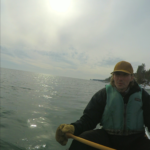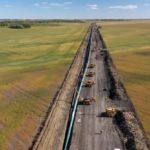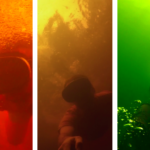Lake Superior Gives Us the Cold Shoulder but Warms Our Hearts
In 2019 I celebrated the first day of summer with my grandchildren on a day trip to Two Harbors. This summer COVID-19 could put a damper on our adventures, but we can still day trip down memory lane.
* * *
At 7:30 a.m., my daughter-in-law launches three-over-the-moon-excited explorers into my house. My grandkids and I eat a hardy voyagers’ breakfast of eggs, sausage, and fruit. After cleaning the kitchen, I prepare to leave home with them for a day-long jaunt. I stow hats, jackets, and spare clothes in a canvas bag and drape Evan’s blanket across the top. Almost three years old, it’s his first adventure with us, but he’s not going without his fluffy fleece blankie.
It’s the first day of summer. Warm spring days near the shores of Lake Superior were scarce this year, and even though the first day of summer delivers sunshine, it’s miserly with warmth. I live four city blocks from Lake Superior, and while I can imagine living closer to it, I can’t imagine living farther from it. Most adventure days with my grandkids involve the lake, even if it only provides scenic backdrop.
Adventure Initiation
“Can we bring our adventure bags?” Michael asks. He’s six, a seasoned explorer like his sister Clara, almost eight.
“Can I have a ’venture bag?” Evan asks.
“Sure,” I say. He beams. If his siblings have it, he wants it.
Clara’s and Michael’s bags are too big for Evan, so I fetch a small cloth bag. I sift through postcards and choose some Minnesota ones. I add a toy and a book and present the bag to Evan. He slips one handle over his left shoulder and the other handle over his right shoulder. The bag rests against his chest, like a breastplate of medieval armor worn by a knight.
“I have a ’venture bag,” he crows. He belongs.
“Yes, you do.” I validate his initiation into our group of explorers. He doesn’t know his bag lacks plastic binoculars, a cheap compass-whistle gadget, auto bingo, and maps.
Piloting the Frontenac
We arrive just before the Two Harbors Lighthouse Museum opens. It’s easier to shepherd three excited children through thin crowds.
To reach the lighthouse grounds, we pass through the gift shop. My grandkids scout toys and trinkets while I buy our tickets.
Beyond the gift shop, we enter a pilothouse that once perched atop the Frontenac. Built in 1923, the iron ore boat was wrecked in 1979 during a blinding snowstorm when she hit a reef near Pellet Island. The pilothouse overlooks Lake Superior, but she’s anchored to land and keeps watch over the same expanse of lake day after day, year after year. She witnesses Lake Superior’s moods, from calm ripples lit by clear skies to crashing waves darkened by angry churning clouds.
My grandkids take turns at the wooden wheel and steer a nonexistent boat to nowhere, but they covet the wheel more than anything else in the pilothouse. When it’s not their turn at the wheel, they each stare at the radar screen, which no longer sends or receives signals. Artifact by artifact they circle inside the pilothouse, and wait for another turn at the helm. I don’t come from a family of sailors, so I’ve never waited for a ship to return safely to harbor. But as my grandkids explore the pilothouse, my thoughts are with sailors who work dangerous jobs. State-of-the-art communications, radar, and forecasting make their jobs safer, but Lake Superior is a daunting adversary when storms crisscross her waters.
While my little seafaring urchins quibble about whose turn it is to steer, I envision the crew who used the equipment in this pilothouse for the last time. I see them alternating between reading instruments and watching a swirling snowstorm. Today the wheel is chained to a brass rail, so young sailors, like mine, can’t go wild at the helm. In 1979, the wheel turned freely, but that didn’t help the crew keep the Frontenac from slamming onto a rocky reef, making her hull howl and shudder as it buckled.
Lake Superior is a boneyard of vessels and sailors. Clear across the lake to the east lies the Edmund Fitzgerald. She was seized by waves, which broke her. She sank with her crew. Up the shore is Pellet Island near Silver Bay where the Frontenac struck a reef. She met her demise, but her crew survived. She’d landed on rocks, which held her up.
Climbing the Two Harbors Lighthouse
“Who wants to see the lighthouse?” I ask. I’m answered by a chorus of “me, me, me.”
We trek up the slope and climb the gray wooden steps to the lighthouse. Clara and Michael scale the tower stairs, more interested in looking out the slit windows than at the displays. When they reach the ladder gallery, the porthole windows give them a bird’s-eye view of the green, gently sloping grounds. “Can we play outside?” they ask. The inside of the lighthouse doesn’t capture their fancy like the inside of the pilothouse did.
The small wooden steps curving along the tower wall are perfectly sized for children, and Evan confidently ascends placing one foot above the other. After reaching the top, he triumphantly descends by sitting on his butt, scooching to the edge of each step, and lowering himself to the next step. At the bottom of the stairs, he raises his hands above his head, then slaps them on his thighs and says, “Again!” He’s enamored with the pint-sized stairs, but it doesn’t take much to coax him outside.
My grandkids scamper up and down the grassy slope, and I’m grateful for the combination of wrought iron and chain-link fencing surrounding the grounds. The sun sits higher in the sky, and we’re no longer alone. I suggest we toss rocks into the lake.
Filling the Lake with Rocks
We amble down the trail to smooth rock formations hugging the shore. Like nimble-footed mountain goats, Clara and Michael climb the formations and pitch rocks into Lake Superior. They gather rocks for Evan, who stands close to me. He throws them, but most fall short of the lake. For a quarter-hour, my grandkids toss rocks into a lake that will spit them back up during her next temper tantrum. I worry one of them will slip and fall off the rocky mounds.
“Who wants to go to Burlington Beach?
“I do,” says Clara.
“Me too,” says Michael.
“Me too,” echoes Evan. If his siblings are going, he’s going.
Burlington Beach has a gentle slope to the water’s edge.
In the time it takes to drive to Burlington Beach, which is under a quarter-hour, Lake Superior changes her mind. She pulls a shade of gray over the morning’s blue sky and dials up the wind machine. The four of us stand on layers of pebbles and stones. The wind infiltrates my clothing, and I wonder how long I’ll have to stand on this beach and freeze while my grandkids toss stones. Michael’s teeth are chattering. And Evan, tilting forward, braces himself against the wind, which has carried off his voice. Clara burrows her hands into her jacket pockets and speaks for them, “Nana, it’s really cold.”
The Adjusted Picnic
Back in the van, they ask about our picnic lunch. The gray skies and gnawing wind don’t speak of picnics.
“We’ll have a picnic in the van,” I say.
“Yay, yay, yay,” they cheer.
I drive to the big white rooster that welcomed us to Two Harbors several hours ago and park the van. We eat and talk about the day’s adventure. The cold temperatures and gusty winds have clipped our plans, but our memories of today are already warm.
Recommended Links:
Leave a Comment
Only registered members can post a comment , Login / Register Here













No Comments